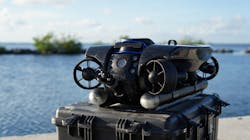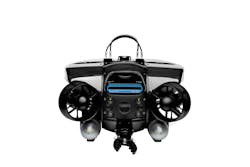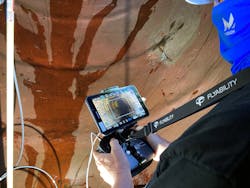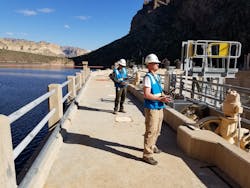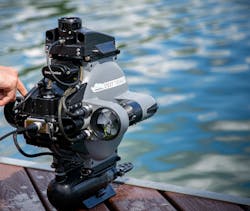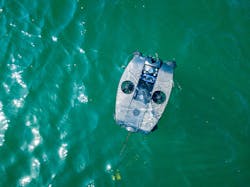Arizona’s SRP Solves Variety of Tasks with In-House Drone Pilots
As drones have gotten smaller and less expensive, Arizona’s Salt River Project has explored how these tools can be used to streamline maintenance across SRP’s power system and watershed which span vast areas across Arizona.
This idea came about in 2016, and the utilities company now uses a fleet of multi-rotor and fixed-wing drones to inspect facilities, evaluate infrastructure, assess equipment, map SRP assets survey accident and storm damage, carry external cargo loads, document SRP’s watershed with video and photography and more.
One of the most recent operations SRP is using drones for is to inspect distribution poles in residential areas, which has recently gone from a pilot program to an ongoing process. The effort has proven invaluable though takes well-crafted coordination between SRP’s distribution team and the utility’s team of pilots specially trained to fly unmanned aerial systems (UAS).
SRP must give residential communities notice when preparing to inspect lines with drones and notify residents at least two weeks in advance with usually at least one reminder notice. The challenge is making sure everyone is aware of the operation, so SRP does not get “non-participants” in any of the footage it captures from the drones.
As a rule, drones do not fly close to homes or residential yards, and drone inspections usually happen in the mornings when most residents have left for work or are indoors working. To help reduce the risk of photographing people or unwanted information with the drones’ cameras, distribution asset inspectors have their own controller for the drone’s camera, and they are careful to only capture the asset when the camera is in the correct position. This also narrows down the volume of inspection documentation that is paired with each ticket generated from inspection flights.
SRP’s UAS pilots are employed under the utility’s Flight Services team which manages SRP’s UAS program and helps ensure the organization complies with the FAA’s evolving drone regulations. The Flight Services team also manages SRP’s manned aircrafts including a plane and helicopters used for operations across SRP’s transmission system. The UAS pilots, along with the various departments they partner with across SRP, have found using drones can be a much simpler, accurate, and cost-effective solution to thoroughly inspect SRP’s assets typically difficult to access.
SRP decided early on it wanted its UAS operators to have certifications that go beyond the FAA requirements. Each operator must pass the FAA Part 107 drone license test, and to stay current from there, SRP Flight Services requires its non-aviator pilots to have at least five UAS takes-off and landings every 30 days to stay up to date on their license.For SRP’s aviators who operate drones as well as manned aircraft, these workers must have at least three UAS take-offs and landings in 90 days to stay current. SRP has two non-aviator pilots as UAS operators and four aviator pilots who also act as UAS operators.
Other utilities are beginning to incorporate drones into their teams, though many use contractors for these operations instead of developing and maintaining an in-house team. As SRP is both a power and water utility, the organization finds multiple uses for drones across operations and has grown to invest more in drone technology. SRP meets with other large utilities who are also using drones and found a common theme is having a centralized team of operators works better than having operators in individual departments. A team of pilots and operators that partners with various departments for different purposes helps keep operations standardized, with more control over legal and safety requirements.
First Flights
SRP serves the Phoenix metropolitan area as a utility, but it also owns and operates generation assets, including several power plants and hydropower facilities. The utility first used a drone for an inspection at a power plant, and since then, application for these has greatly expanded.
At first, SRP thought the best solution would be to have drone operators in departments across the utility, but quickly discovered it made more sense to have the drone team part of the centralized Flight Services department. In 2017, an SRP committee formulated a policy that outlined how the team would be managed from legal and safety perspectives, ensuring all UAS operators abide by FAA regulations and are proficient in their practices by always staying current in how often they are operating these devices.
The utility’s Flight Services department uses drones that range from about $6,000 to about $40,000, which is cost effective when drone costs from a decade ago are compared. Today’s drones are also lighter, more maneuverable and able to carry sophisticated cameras and sensors that enable them to perform some of the same tasks as utility personnel, but from a safe distance. Back when SRP first got the idea to examine drone technology, UAS’s with cameras and video capability were mostly used in the movie industry and had not yet been scaled down for other purposes.
Distribution Pole Inspection with Drones
With a more traditional residential-pole inspection method –using binoculars and visually surveying individual poles– SRP’s crew of distribution inspectors could examine an average of 30 to 40 poles in a day – perhaps 50 at most. Now, with the use of drones and UAS cameras, SRP’s crew has discovered they can inspect more than 130 to 140 poles in a day, cutting a full 500-pole circuit inspection job, usually lasting two weeks, down to about three to five days total.
By using drones, not only has the time required for inspections fallen, the level of accuracy and efficiency has improved tenfold. Precision in inspections greatly enhances power reliability. As drones go from pole to pole, there are two drone controllers – one controlling the aircraft, and one operating the camera to take high-resolution images and video as well as thermal images of the poles.
The drones capture the complete condition of the asset in detail, and UAS controllers work with distribution operators to zoom in on certain parts of the poles to thoroughly examine for damage or equipment that may need to be replaced. The crew inspects roughly 20 poles as a time before returning to their vehicle to upload an inspection report and swap out the battery on the drone which has a battery life of 30 minutes.
The entire operation has added value beyond the distribution team’s imagination. They have been able to proactively identify damage to poles that may have not been recognized if not for the level of detail the drones can capture. The number of team members necessary for these inspection crews has also scaled down, helping to reduce costs and necessary resources.
Additional Uses for Drones: Land and Water
Even when it comes to inspecting assets like large boilers at its power plants, SRP has found using drone technology gives us the ability to access hard-to-reach areas, reduce safety risks and allow for more flexible scheduling. Drones eliminate the need for scaffold erection and sky-climber setup costs for many of its power resource inspections. This type of job can cost up to $26,000 when using scaffolding to inspect duct burners. Beyond cost savings, drones make it easier, safer, and quicker to capture inspection videos that experts can then analyze from different locations.
And as SRP is the Phoenix metropolitan area’s largest supplier of water in addition to being the area’s largest supplier of electricity, with multiple hydropower resources, the utility found drones can be just as valuable underwater. Now, SRP is using underwater drones, or remotely operated vehicles (ROVs), to inspect assets along SRP’s watershed.
Last year, SRP’s Operating & Maintenance Hydro Supervisor called the SRP Flight Services crew see if they could help innovate a new way to inspect the carbon fiber liners in one of SRP’s dams. These penstocks are the intake structures that control water flow to the dam. Ordinarily, this annual inspection would require that scaffolding be constructed so crew members could descend into the penstock to inspect it up close. The supervisor suspected that drone technology could streamline this process, and he was right.
After researching options, one of SRP’s senior UAS pilots determined a Flyability Elios 2 drone was ideal for the job, as its small, spherical shape could easily fit through the smooth and narrow penstock. He traveled to the dam and was able to complete an inspection that used to take days in under an hour. In addition to the time savings, the underwater drone also eliminated the safety risks an underwater inspection poses to employees.
It eliminated the need to set up scaffolding, and the added benefit is a cost savings of $10,000 per year. SRP also believes it may be the first utility to fly a drone inside the penstock of a hydrogeneration facility from the turbine to the inlet gate.
Flight Services’ other UAS pilots also use a Deep Trekker Revolution ROV with sonar and a grabber arm to inspect tailrace trash racks and inlet gates. This allows them to recover debris before it creates problems in a dam.
Flight Services is now looking into the possibility of using drone technology to salvage equipment that may have fallen into dams so it can be repaired.
Flying Forward
SRP’s teams across its power and water operations will continue to help determine the path forward for using drones. Luckily, the utility has an extremely skilled UAS team willing and able to identify the equipment needed for the various jobs and how to experiment with it. UAS operations continue to make a valuable impact across the organization’s operations.
Since the UAS program at SRP officially began in 2017, the team has completed more than 300 flights and 90 operations. There are currently four UAS pilots working in SRP’s Flight Services, though this number stands to increase as the team continues to evolve and show their tremendous value.
Kate Kochenderfer is the senior director of Supply Chain, Transportation and Flight Services at Salt River Project (SRP) and has been with the utility since 2012. Kochenderfer received her Bachelor of Science from Northern Arizona University and her Master of Science from Grand Canyon University. She is the current Chair of the Glendale Chamber of Commerce.
About the Author
Kate Kochenderfer
Kate Kochenderfer is the senior director of Supply Chain, Transportation and Flight Services at Salt River Project (SRP) and has been with the utility since 2012. Kate received her Bachelor of Science from Northern Arizona University and her Master of Science from Grand Canyon University. She is the current Chair of the Glendale Chamber of Commerce.
